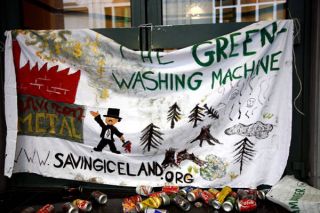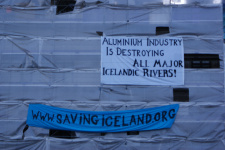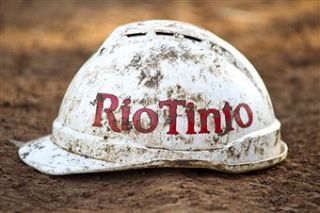Sep 25 2008
Saving Iceland Disrupts International Aluminium Conference in Germany
Today, the 11th International Conference on Aluminium Aloys (ICAA) met with angry protests. Activists from the environmentalist network Saving Iceland disrupted the proceedings at the University in Aachen. Early this morning, during one of Rio Tinto Alcan’s lectures, the fire alarms in the building were put on. Later today – again during Rio Tinto Alcan’s lecture – stink bombs were thrown and a high volume rape alarm was put on and suspended out of reach by green and black helium baloons. The auditorium was also strewn with information leaflets. The aim was to call attention to the industry’s singular involvement in ecological destruction in Iceland, as well as on a global scale.
The ICAA conference is a weeklong event held at a different international location every 2 years. This is its first appearance in Germany and as such is run in parallel to the Aluminium trade fair in Essen, about 80 km away. This double event is sure to call together all major players of an industry that still tries to present itself as having a green conscience, and with some success: Alcoa has been included in the Dow Jones Sustainability Index, for the 7th year running. [1] Environmentalists dispute this depiction in the strongest terms.



 Alcoa has
Alcoa has 
 In a special report on the environment, Thórunn Sveinbjarnardóttir, minister for the environment in Iceland, says that Icelandic nature has suffered from aluminium production and needs increased protection. “It is time to correct the injustice nature and environmental protection has faced because of heavy industry,” says the report.
In a special report on the environment, Thórunn Sveinbjarnardóttir, minister for the environment in Iceland, says that Icelandic nature has suffered from aluminium production and needs increased protection. “It is time to correct the injustice nature and environmental protection has faced because of heavy industry,” says the report.